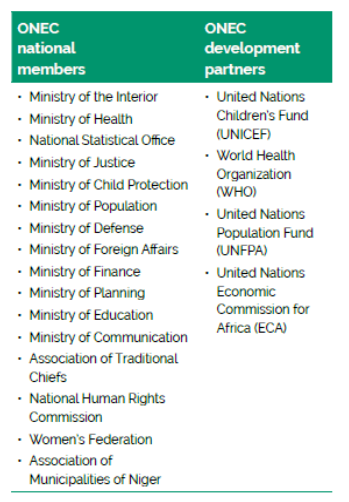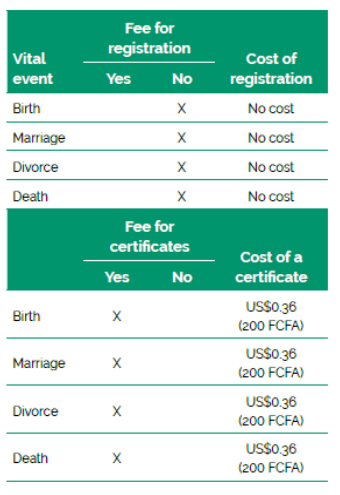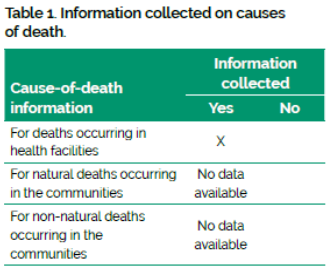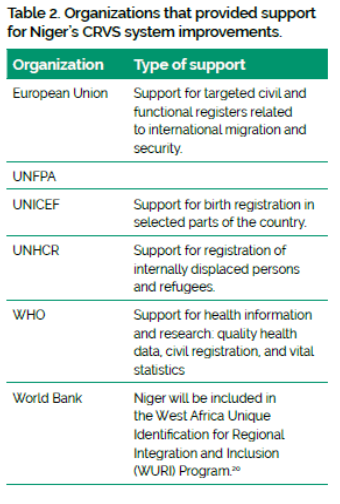Introduction
The purpose of this report is to provide a brief introduction to the civil registration and vital statistics (CRVS) system in Niger. The information is based on a questionnaire completed by the Niger Civil Registry along with a desk review of publicly available documents on CRVS in Niger. Among other things, this report presents:
- Background information on the country;
- Selected indicators relevant to CRVS processes;
- Stakeholders’ activities; and
- Resources available and needed to strengthen CRVS systems.

Disclaimer: The boundaries and names shown and the designations used on this map do not imply official endorsement or acceptance by the United Nations.
Country profile
Niger is a landlocked country in West Africa that is named after the Niger River. It is bordered by Libya to the northeast, Chad to the east, Nigeria to the south, Benin to the southwest, Mali and Burkina Faso to the west, and Algeria to the northwest. Six of these countries are facing a crisis of one kind or another. This has led to an influx of refugees, and some of the conflicts have spilled over into Niger.
1, 270,000
24.2
CRVS Dimensions
Birth
| Completeness of birth registration |
66.5% (2019 |
| Children under 5 whose births were registered |
66.5% (2019 |
| Births attended by skilled health professionals |
39.7% (2018 |
| Women aged 15-49 who received antenatal care from a skilled provider |
36.9% (2012 |
| DPT1 immunization coverage among 1-year-olds |
92% (2019 |
| Crude birth rate (per 1,000 population) |
21 (2015 |
| Total fertility rate (live births per woman) |
7.4 (2015 |
| Adolescent fertility rate (per 1,000 girls aged 15-19 years) |
183.5 (2018 |
| Population under age 15 |
50% (2018 |
Death
| Completeness of death registration |
3.24% (2007 |
| Crude death rate (per 1,000 population) |
10.7 (2015 |
| Infant mortality rate (probability of dying by age 1 per 1,000 live births) |
66 (2015 |
| Under five mortality rate (probability of dying by age 5 per 1,000 live births) |
119 (2015 |
| Maternal mortality ratio (per 100,000 live births) |
553 (2018 |
Marriages and divorces
| Marriage registration rate |
Not available |
| Women aged 20-24 first married or in union before age 15 |
Not available (N/A) |
| Women aged 20-24 first married or in union before age 18 |
76% 2017 |
| Divorce registration rate |
Not available |
Vital statistics including causes of death data
| Compilation and dissemination of CR-based statistics |
Not available (N/A) |
| Medically certified causes of death data |
Not available (N/A) |
Civil registration system
Legislative Framework
In 2019, the law that governs civil registration was upgraded. This was the third restructuring of the law since independence from France in 1960; the last time this was done was in 2007. The new civil registration bill was approved on 29 July 2019 (Loi n0 2019-29 du 1er juillet 2019 portant sur le régime de l’Etat civil au Niger) and decreed on 23 August that same year. The new text reflects the continental recommendations to improve the civil registration systems in each country and takes into consideration birth, marriage, divorce, and death registration.
Management, organization and operations
The national civil registration authority in Niger is the Directorate of Civil Status, Migration and Refugees, under the Ministry of the Interior. These are the other ministries and agencies responsible for notifying vital events:
- Ministry of the Interior;
- Ministry of Public Health;
- Ministry of Justice;
- Ministry of Foreign Affairs; and
- Ministry of National Defense.
National CRVS systems coordination mechanisms
Niger has a national CRVS coordination committee, the Observatoire National de l’État Civil (ONEC). It was created by Order No. 0309/MI/SP/D/ACR/DGECR, dated 27 April 2015.

Administrative level registration centres
Niger has a decentralized civil registration system, with 11,638 registration offices throughout the country. Of these, 582 are in urban areas and 11,056 are in rural areas. The offices are serviced by 618 registrars. Niger also has auxiliary registration offices in some hospitals and health centres; their main responsibility is to issue notification certificates (déclaration in French).
Nigerians living abroad may register vital events at the country’s diplomatic missions. These missions can also preside at and register marriages. Given the size of the country and the difficult infrastructure conditions, information does not flow in a timely and secure manner. Storage of vital event records is complicated by the hot, dry climate, making it a challenge to obtain copies of documents.
Accessibility of civil registration services
Most people live less than 1 km from the nearest local civil registration office. Estimates indicate that it would take less than 1 hour for most service seekers to reach the nearest office.
Registration of vital events
The notification and registration of vital events is done manually. Two copies are made of the notification: one copy is archived at the point of registration, and the second copy is sent to the civil registry office.
Birth registration
For the registration of births, three copies are made:
- the first copy is archived by the civil registry;
- the second copy is sent to the Bureau of Statistics “with some frequency”; and
- the third copy is for the child (parents).
Death registration
No information available
Marriage registration
No information available
Registration fee
These are the direct costs linked to the registration and certification of vital events:

Backlog of unregistered births
The backlog of unregistered births is 33 percent. Also, for vital events that are registered, some people have not picked up their certificates.
Vital statistics system
The Niger National Institute of Statistics (INS) was created in 2004. It is regulated by Law 2004-011 Concerning the organization of the statistics activities and creation of the National Institute of Statistics (Loi no 2004-011 du 30 mars 2004 Portant sur l’organisation de l’activité statistique et créant l’Institut National de la Statistique).
The collection of vital statistics is required, but collecting, compiling, and disseminating these is complicated by the fact that registration is manual and paper based.
Also, information is not submitted on a regular basis; the last report on vital statistics was published in 2014.
Causes of death
Cause-of-death information is collected and recorded by region for deaths occurring in health facilities only. The latest report available online is the Annual Statistical Report by the Ministry of Health (2017).

Digitization
Computerization
Since 2016, Niger has had a High Commissioner of Information and Communications Technology in charge of the country’s e-government strategy. In 2017, the National Agency for the Information Society (ANSI) was established: it is responsible for managing the National Data Centre. ANSI, along with the Ministry of Digital Economy, is responsible for creating a system for establishing and managing people’s electronic identity.
The registration of births, marriages, and deaths in Niger continues to be paper based, but there are plans to digitize records and use computers more widely. Factors preventing the use of computers have been a lack of stable electricity grids and limited internet coverage.
Mobile technology application
There are no mobile applications for the notification or registration of vital events. However, with 40.5 mobile subscriptions for every 100 people in 2017, it is estimated that 80 percent of the population has access to the 2G mobile network.
Improvement initiatives and external support
Improvement plan and budget
Budgetary allocations and requirements
The budget needed for this plan is estimated at US$120 million; information on the actual budget allocation is not available.
Activities identified as high priorities The prioritized activities in the current national plan are:
- Capacity building for civil registration;
- Computerization of the civil registration system;
- Statistical production of vital statistics; and
- Social mobilization.
Support from development partners
The development partners that provided and continue to support the civil registration and vital statistics systems improvement initiative are listed below.

Additional Materials
Websites
Additional materials
Annan, F. and Sanoh, A. 2017. Mobile Infrastructure and Rural Business Enterprises: Evidence from Sim Registration Mandate in Niger. Washington, D.C. World Bank Group. openknowledge.worldbank. org/bitstream/handle/10986/29069/WPS8278.pdf?sequence=1&isAllowed=y
Ministère de l’Intérieur, de la Sécurité Publique, de la Décentralisation et des Affaires Coutumières et Religieuses. 2019. Document d’orientation de la politique nationale de l’état civil. Direction Générale de l’État Civil, des Migrations et des Refugiés.interieur.gouv.ne/
République du Niger. 2019. Quinzième rapport périodique de la république du Niger sur la mise en oeuvre de la charte africaine des droits de l’homme et des peuples couvrant la période 2017–2019, présenté en vertu de l’article 62 de ladite charte. achpr.org/public/Document/file/French/NIGER%2015%20%C3%A8me%20RAPPORT%202017-2019_FRE%20.pdf
United Nations Development Programme (UNDP). 2019. Human Development Report 2019: Beyond income, beyond averages, beyond today. Inequalities in human development in the 21st century. New York, NY. hdr.undp.org/sites/default/files/hdr2019.pdf
Wodon, Q. and Yedan, A. 2019. Obstacles to birth registration in Niger: Estimates from a recent household survey. Journal of Health, Population and Nutrition, 38(S1). jhpn.biomedcentral.com/articles/10.1186/s41043-019-0185-1
World Bank. 2017. ID4D Diagnostic: Niger Country Report. Washington, D.C. pubdocs.worldbank. org/en/755391518449923372/ID4D-Niger-IMSAEnglish-012248.pdf
Conclusion
Niger has made progress in civil registration over the past 15 years, especially with respect to revising and updating the legal framework. However, gaps and challenges remain, particularly when it comes to institutional and administrative capacity.
The country’s high poverty rate (41.4 percent in 2019)
Although Niger ranks last in the UN’s Human Development Index (HDI), the report notes that inequality has fallen substantially “as the incomes of the bottom 40 percent grew 35 percentage points more than the average.”
Niger is aligned with efforts in Africa to improve CRVS systems and has developed a National CRVS Strategy. It will require resources to make the plan operational and to implement it. Given the recent major investment the country has made to upgrade the legal framework for civil registration, a next step should be to analyze the institutional and administrative capacity of both the civil registration system and the vital statistics system. It will then be possible to assess their ability to implement the modernization arrangements so that Niger has the CRVS system it needs.
Endnotes
[footnotes]